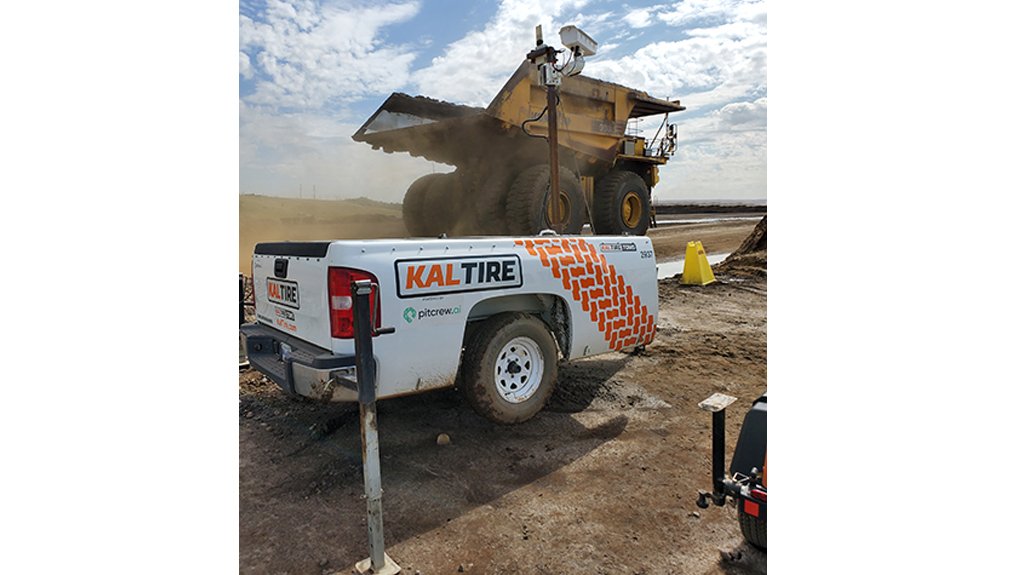Kal Tire exhibits prototype technologies at Electra
At this year’s Electra Mining exhibition in Johannesburg, Canadian tyre company Kal Tire is showcasing prototypes for two unique tools that aim to improve safety and reduce unnecessary waste and expenditure in the tyre management space in mining.
The first of these, named Wheel Inspection, will allow mines to inspect wheel rims on-site instead of spending large sums transporting the large and heavy steel structures hundreds of kilometres to be inspected at the manufacturer’s facilities, which is costly and time-consuming.
Once inspected, it is determined whether they are either safe for use, need repairs or should be scrapped.
The alternative to these costly inspections is to take the wheels out of use after a set number of hours, even though the rim may have months of safe performance left – leading to wasteful expenditure.
The aim of the mobile Wheel Inspection technology is to eliminate unexpected, costly breakdowns and help protect technicians from risk, such as injury from the force of a catastrophic wheel failure.
Wheel rims can develop fractures along welds, ring grooves and holes. If left unchecked, the severity of these cracks can increase, leading to leaks and wheel failures.
The Wheel Inspection is a portable, on-site solution that follows the circumference of a wheel to scan for signs of cracking using an electromagnetic nondestructive testing system for rapid crack and corrosion assessment.
The scope is designed to hug complex shapes, including welding points and ring grooves and detect cracks one should be concerned about.
“Having that rim integrity data means more rims in use that are safe for the pressures of the job. For customers to be able to perform rim inspections at the mine site will save costs and also provide quicker responses about which wheels can safely return to operation,” Kal Tire mining tyre group senior VP Dan Allan explained.
He told Mining Weekly that Kal Tire intends to add this technology into the company’s service offering going forward – once further testing of the technology has been carried out in the coming months – enabling on-site inspection of wheels for clients.
Meanwhile, the Kal Clamp is another prototype technology that Kal Tire is exhibiting at Electra Mining. It allows tyre technicians to safely perform the last, and most dangerous, step of removing or installing an off-the-road (OTR) tyre and wheel assembly.
The Kal Clamp is a remote-controlled clamp that secures and then releases the last four wheel bolts to prevent technicians from having to stand underneath a tyre manipulator forklift, which bears the weight of the assembly and poses a significant risk to the technician.
“We’ve invested in developing these tyre management tools because we believe every team member should be able to return home safely at the end of the day. Now technicians can perform the highest risk part of that tyre and wheel work from a safe distance,” Allen said.
Instead of removing the final four wheel nuts at the three o’clock and nine o’clock positions last, the technician removes those wheel nuts first. Next, he mounts the Kal Clamp on both the three o’clock and nine o’clock studs to secure the wheel and lock it in place. When the Kal Clamp’s jaws have locked the studs, he removes all the other wheel nuts and then steps far back so that the tyre handler can approach and establish a secured grip on the assembly.
The technician then presses a switch on the remote control, which causes the clamps to loosen and the assembly to dismount with no risk to the technician.
The Kal Clamp is designed to operate on wheels and rims from 51” to 63” and features a flexible mechanical system that can fit different rim models.
Allen said the company intends to make the Kal Clamp available on the market as standalone product, and that both the Wheel Inspection and Kal Clamp technology would be made available in 2023.
FOCUS ON ESG
Aside from the new technologies on display, Allen emphasised that the company was responding to the increasing demand from mining customer for more environment, social and governance- (ESG-) conscious technologies and solutions that would help them drive their emissions down, reduce waste and increase safety at their operations.
In this regard, Kal Tire also punted its Maple Program and custom-built carbon calculator. Using this, customers can receive yearly certificates containing accredited data about their fuel and carbon emissions savings when using sustainability solutions such as retreading, Kal Tire’s Ultra Repair, and conventional repairs to OTR tyre sizes larger than 49”.
Tyres with large but less complex injuries can effectively be restored and returned to service through the patch and process of conventional repairs.
“With our sustainability solutions included in the Maple Program, we provide an important and accessible way for mines to reduce costs and their carbon footprint while extending tyre life,” says Kal Tire mining tyre group Southern Africa VP John Martin explained.
To meet the growing demand for OTR tyre repairs, especially in the thriving copper and iron-ore region of Northern Cape, Kal Tire recently opened a new branch and repair facility in Hotazel.
It has also opening a facility in Mozambique.
Additionally Kal Tire showcased its thermal conversion OTR tyre recycling facility in northern Chile, which can process five 63” tyres, or 20 000 kg, daily, creating 6 500 ℓ of alternative fuel, 4 000 kg of steel and 8 000 kg of carbon black, as well as enough synthetic gas to fuel the plant itself for seven hours.
Martin said there was significant potential to bring the technology to South Africa but that various regulatory issues would need to be ironed out before it could be done owing to the complexity surrounding the government-imposed tyre levy of R2.30/kg, which is meant to be used for the recycling and environmentally sound disposal of used tyres.
“We’re prepared to make the investment. What we need is to make sure that customers are indeed committed to that end-of-life solution. Also, we need to figure out how we will get access to the levy already being paid and make sure that money is going back into the handling of their tyres,” Allen said.
Martin said South African mines were eager to develop a tyre abatement programme that was sustainable and ethical, suggesting that there were millions of tonnes of scrap mining tyres stockpiled on mine sites and dedicated stockpiling areas throughout the country.
“We pay the government to recycle, but we know that they're not going to do it and that they can't afford to do it. It might seem complex, but we can learn a lot from what’s been done in Chile,” he said.
Kal Tire’s OTR tyre recycling plant employs a unique thermal conversion process that uses heat and friction to induce a reaction that converts tyres into their base elements. Since the tyre pieces are heated in a vacuum with no oxygen, there’s no combustion and no smoke.
Kal Tire also demonstrated at the Electra exhibition this week how its Tire Operations Management System (TOMS) had been integrated with the thermal imaging cameras and software of Pitcrew.ai. After combining the technologies, Kal Tire began introduce automated tyre inspection stations to sites in Australia, Canada, Chile and soon to Mozambique.
Mine sites have long been able to use tyre pressure monitoring systems, which give a clear picture of what is happening inside a tyre; however, the new autonomous tyre inspection technology can now assess what is happening on the outside of the tyre and automate the necessary steps to take action.
“As mining trucks pass by, the stations monitor front and rear tyres, and the artificial intelligence software searches thermal imaging video footage for anomalies such as hot spots, belt edge and tread separations,” explained Kal Tire mining tyre group mining technology solutions manager Christian Erdelyi.
For example, a haul truck passes the inspection station, which captures and detects a hot tyre. That finding, and all other findings, are reported into TOMS. The system then automates an inspection work order as part of a self-reinforcing feedback loop. Next, TOMS plans tyre change work as necessary, based on damage severity.
“Having more tyres on the road performing safely means sites can improve haul truck productivity, team efficiency and safety,” Allen said.
Article Enquiry
Email Article
Save Article
Feedback
To advertise email advertising@creamermedia.co.za or click here
Press Office
Announcements
What's On
Subscribe to improve your user experience...
Option 1 (equivalent of R125 a month):
Receive a weekly copy of Creamer Media's Engineering News & Mining Weekly magazine
(print copy for those in South Africa and e-magazine for those outside of South Africa)
Receive daily email newsletters
Access to full search results
Access archive of magazine back copies
Access to Projects in Progress
Access to ONE Research Report of your choice in PDF format
Option 2 (equivalent of R375 a month):
All benefits from Option 1
PLUS
Access to Creamer Media's Research Channel Africa for ALL Research Reports, in PDF format, on various industrial and mining sectors
including Electricity; Water; Energy Transition; Hydrogen; Roads, Rail and Ports; Coal; Gold; Platinum; Battery Metals; etc.
Already a subscriber?
Forgotten your password?
Receive weekly copy of Creamer Media's Engineering News & Mining Weekly magazine (print copy for those in South Africa and e-magazine for those outside of South Africa)
➕
Recieve daily email newsletters
➕
Access to full search results
➕
Access archive of magazine back copies
➕
Access to Projects in Progress
➕
Access to ONE Research Report of your choice in PDF format
RESEARCH CHANNEL AFRICA
R4500 (equivalent of R375 a month)
SUBSCRIBEAll benefits from Option 1
➕
Access to Creamer Media's Research Channel Africa for ALL Research Reports on various industrial and mining sectors, in PDF format, including on:
Electricity
➕
Water
➕
Energy Transition
➕
Hydrogen
➕
Roads, Rail and Ports
➕
Coal
➕
Gold
➕
Platinum
➕
Battery Metals
➕
etc.
Receive all benefits from Option 1 or Option 2 delivered to numerous people at your company
➕
Multiple User names and Passwords for simultaneous log-ins
➕
Intranet integration access to all in your organisation



















